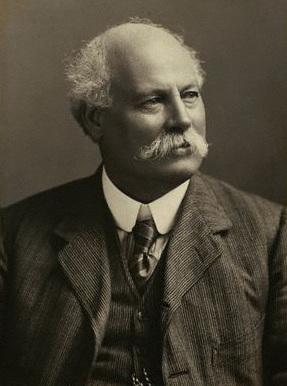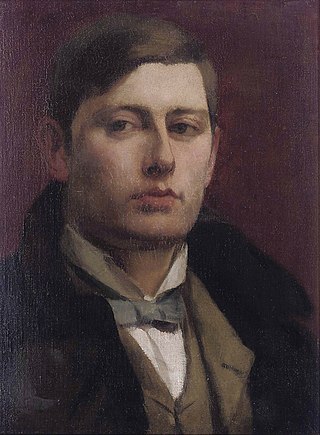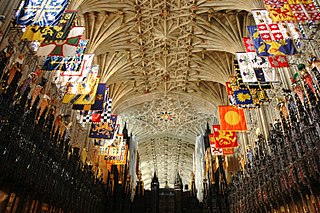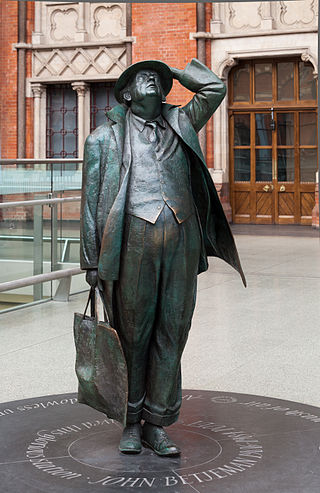
Douglas Jennings MRSS (born 24 September 1966)[ citation needed ] is an English sculptor and a Member of the Royal Society of Sculptors. [1]

Douglas Jennings MRSS (born 24 September 1966)[ citation needed ] is an English sculptor and a Member of the Royal Society of Sculptors. [1]
Jennings studied Classical figurative sculpture at Stafford Art College and was inspired by the works of Bernini and Michelangelo.
Between 1999 and 2003 he specialized in portrait sculpture for Madame Tussauds and was responsible for waxwork models of Ken Livingstone, Charles Kennedy, Robin Williams and Nicolas Cage in 2008.
Jennings trained as a classical sculptor and is a life member of the Royal British Society of Sculptors. He specialises in producing monumental art works for public figures in the world of sport, entertainment and politics. His artwork is in private and public collections worldwide. [2] He is known for producing public sculpture that captivates with its level of detail, naturalistic style and the beauty of his work. [1]
Jennings completed a bronze memorial of Johnny Haynes in 2008. Installed at Fulham FC, Haynes is widely regarded as the greatest footballer ever to play for the London club. He also made 56 appearances for England, including 22 as captain. In 2017 Douglas completed another commission for Fulham FC – a commemorative bronze statue of George Cohen MBE. The piece was unveiled at Fulham FC to celebrate Cohen's remarkable career and the 50th anniversary of England's famous World Cup victory in 1966. [3] [4] [5]
In 2015 the quality of Douglas's work was commended by the Public Monuments and Sculpture Association. He was presented with the Marsh Award for Excellence in Public Sculpture for his WWII memorial statue of Squadron Leader Mahinder Singh Pujji. [6] This was commissioned by Gravesham Borough Council and is located in public parkland by the River Thames. [7]
In 2016 Jennings was commissioned to create a bronze memorial statue of Margaret Thatcher dressed in full ceremonial robes of the House of Lords. The piece was planned to be erected in Parliament Square, but controversially, Westminster council turned down the plan because of what officials describe as "monument saturation". [8] On 15 May 2022, the new statue was installed on St Peter's Hill Green in Thatcher's home town of Grantham, close to Grantham Museum, but was attacked with eggs within two hours of its unveiling. [9]
Jennings created a statue of the Queen to mark Her Majesty's 90th birthday celebrations, in 2018. The artwork was commissioned by Gravesham Council and is believed to be the only statue showing the Queen seated. The bronze statue, mounted on a stone plinth, features the monarch dressed in her Order of the Garter robes. [10]

Ian Rank-Broadley FRBS is a British sculptor who has produced many acclaimed works, among which are several designs for British coinage and the memorial statue of Princess Diana at Kensington Palace in London unveiled on her 60th birthday in 2021.

The Albert Memorial, directly north of the Royal Albert Hall in Kensington Gardens, London, was commissioned by Queen Victoria in memory of her beloved husband Prince Albert, who died in 1861. Designed by Sir George Gilbert Scott in the Gothic Revival style, it takes the form of an ornate canopy or pavilion 176 feet (54 m) tall, in the style of a Gothic ciborium over the high altar of a church, sheltering a statue of the prince facing south. It took over ten years to complete, the £120,000 cost met by public subscription.

Sir Joseph Edgar Boehm, 1st Baronet, was an Austrian-born British medallist and sculptor, best known for the "Jubilee head" of Queen Victoria on coinage, and the statue of the Duke of Wellington at Hyde Park Corner. During his career Boehm maintained a large studio in London and produced a significant volume of public works and private commissions. A speciality of Boehm's was the portrait bust; there are many examples of these in the National Portrait Gallery. He was often commissioned by the Royal Family and members of the aristocracy to make sculptures for their parks and gardens. His works were many, and he exhibited 123 of them at the Royal Academy from 1862 to his death in 1890.
Philip Henry Christopher Jackson CVO DL is a Scottish sculptor, noted for his modern style and emphasis on form. Acting as Royal Sculptor to Queen Elizabeth II, his sculptures appear in numerous UK cities, as well as Argentina and Switzerland.

The Queen Victoria Gardens are Melbourne's memorial to Queen Victoria. Located on 4.8 hectares opposite the Victorian Arts Centre and National Gallery of Victoria, bounded by St Kilda Road, Alexandra Avenue and Linlithgow Avenue.

Baron Pietro Carlo Giovanni Battista Marochetti was an Italian-born French sculptor who worked in France, Italy and Britain. He completed many public sculptures, often in a neo-classical style, plus reliefs, memorials and large equestrian monuments in bronze and marble. In 1848, Marochetti settled in England, where he received commissions from Queen Victoria. Marochetti received great recognition during his lifetime, being made a baron in Italy and was awarded the Legion of Honour by the French government.

Sir Thomas Brock was an English sculptor and medallist, notable for the creation of several large public sculptures and monuments in Britain and abroad in the late nineteenth and early twentieth centuries. His most famous work is the Victoria Memorial in front of Buckingham Palace, London. Other commissions included the redesign of the effigy of Queen Victoria on British coinage, the massive bronze equestrian statue of Edward, the Black Prince, in City Square, Leeds and the completion of the statue of Prince Albert on the Albert Memorial.

John Henry Foley, often referred to as J. H. Foley, was an Irish sculptor, working in London. He is best known for his statues of Daniel O'Connell for the O'Connell Monument in Dublin, and of Prince Albert for the Albert Memorial in London and for a number of works in India.

Sir George James Frampton, was a British sculptor. He was a leading member of the New Sculpture movement in his early career when he created sculptures with elements of Art Nouveau and Symbolism, often combining various materials such as marble and bronze in a single piece. While his later works were more traditional in style, Frampton had a prolific career in which he created many notable public monuments, including several statues of Queen Victoria and later, after World War I, a number of war memorials. These included the Edith Cavell Memorial in London, which, along with the Peter Pan statue in Kensington Gardens are possibly Frampton's best known works.

Ian G. Brennan is the official sculptor to the Most Noble Order of the Garter and Most Honourable Order of the Bath. Brennan has received over ninety-five commissions for the Royal Household; these include over seventy-five carved and painted crowns, coronets and crests. Those of the Garter knights have been installed in St George's Chapel at Windsor Castle. Those of the Knights of the Bath have been installed in Henry VII Lady Chapel at Westminster Abbey.

The fourth plinth is the northwest plinth in Trafalgar Square in central London. It was originally intended to hold an equestrian statue of William IV, but remained empty due to lack of funds. For over 150 years, its use was debated; in 1998, the Royal Society for the encouragement of Arts, Manufactures and Commerce (RSA) commissioned three contemporary sculptures to be displayed temporarily on the plinth. Shortly afterwards, Chris Smith, Secretary of State for Culture, Media and Sport, commissioned Sir John Mortimer to seek opinions from public art commissioners, critics and members of the public as to its future. Mortimer's final report recommended that there continue to be a rolling programme of commissioned temporary artworks rather than settle permanently on one figure or idea.
Alfred Turner was an English sculptor notable for several large public monuments. These included statues of Queen Victoria, works in the Fishmonger's Hall in London and several war memorials, both in the Britiah Isles and abroad.
Angela Conner FRSS is an English sculptor who works in London. Conner has exhibited internationally and has large scale sculptures in public and private collections around the world.

Martin Jennings, FRSS is a British sculptor who works in the figurative tradition, in bronze and stone. His statue of John Betjeman at St Pancras railway station was unveiled in 2007 and the statue of Philip Larkin at Hull Paragon Interchange station was presented in 2010. His statue of Mary Seacole (2016), one of his largest works, stands in the grounds of St Thomas' Hospital in central London, looking over the Thames towards the Houses of Parliament.

George Edward Wade was a British sculptor. He was largely self-taught as an artist and is best remembered for his statues of royalty and politicians.

The statue of Edward VII in Bangalore is located at Queen's Park, next to Cubbon Park, Bangalore Cantonment, at the junction of Queen's Road and Cubbon Road. The statue was unveiled on November 1919 by the then Viceroy and Governor-General of India, Frederic John Napier, Baron Chelmsford. The statue was raised out of funds raised by the residents of the Bangalore Civil and Military Station. The Statue of King Edward VII is one of the few of the original statues which were installed in British India, to still stand at its original location. The statue rises above a flowering frangipani tree. On the other end of Queen's Park is the Statue of Queen Victoria, Bangalore. The statue was designed and sculpted by Leonard Jennings of Chelsea, London.

The statue of Mary Seacole stands in the grounds of St Thomas' Hospital, Lambeth, London. Sculpted by Martin Jennings, the statue was executed in 2016. It honours Mary Seacole, a British-Jamaican who established a "British Hotel" during the Crimean War and who was posthumously voted first in a poll of "100 Great Black Britons".

Eve Shepherd MRSS is a British sculptor.

A statue of Margaret Thatcher stands in her birthplace, the town of Grantham in Lincolnshire, England. The statue is 10 feet 6 inches (3.2 m) high, cast in bronze, and depicts the late British prime minister Baroness Thatcher, dressed in the full ceremonial robes of the House of Lords. It stands on a 10-foot-6-inch (3.2 m) plinth. Created by sculptor Douglas Jennings, and costing £300,000, it was erected on 15 May 2022, on St Peter's Hill Green, close to the Grantham Museum. Eggs were thrown at the statue within two hours of its installation, and a week later red paint was thrown at it. It was formally unveiled on 31 May.

Wellington's Queen Victoria Monument is an early 20th-century statue of Queen Victoria by British sculptor Alfred Drury. Copied after Drury's earlier 1903 Portsmouth statue, Victoria is depicted standing triumphantly in her Robe of State and widow's cap, holding a royal scepter and orb. The monument's plinth additionally features a plaque and three bronze reliefs, designed in the New Sculpture style, depicting the Treaty of Waitangi and various artistic and scientific inventions of the Victorian era.